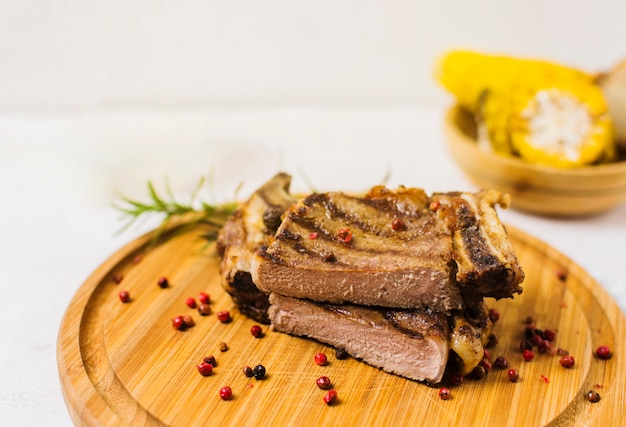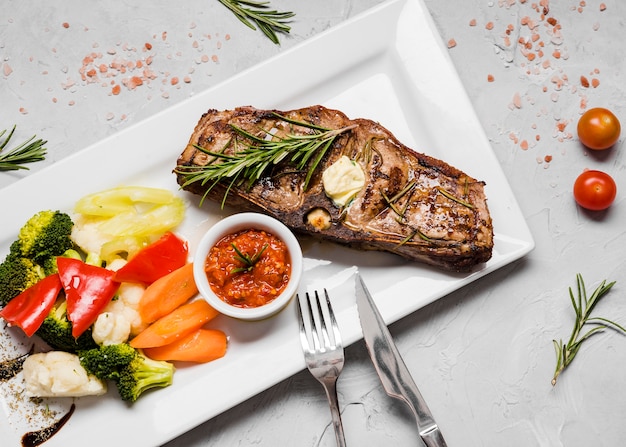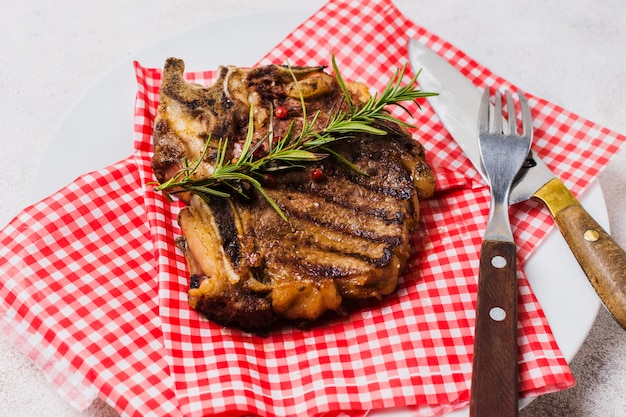Let me tell you, there's nothing quite like a perfectly cooked venison tenderloin. It's tender, flavorful, and a true culinary treasure. But I know, sometimes it can feel a bit intimidating, especially if you're new to cooking venison. That's why I'm here to guide you through every step, from choosing the right cut to creating mouthwatering dishes. Whether you're a seasoned hunter or a curious foodie, this guide will equip you with the knowledge and confidence to cook venison like a pro.
So, grab a cuppa, get cozy, and let's embark on this delicious journey!
(Part 1) Choosing the Right Cut: The Foundation of a Great Meal

First things first, let's talk about the heart of the matter - the tenderloin. It's the prized cut, known for its delicate texture and rich, gamey flavor. But, choosing the right piece for your culinary vision is essential. Let's break down the different cuts and their unique characteristics:
Understanding the Different Cuts: A Guide to Venison Tenderloin
Imagine the deer tenderloin as a long, thin muscle running along the backbone. It's often divided into smaller sections, each with its own strengths and potential applications.
- The "Medallion": Think of these as the darling of the tenderloin world. Typically 1-2 inches thick, they're perfect for grilling, pan-searing, or even roasting, delivering a quick and flavorful meal.
- The "Steak": This is a larger, heftier cut, usually around 1.5-2 inches thick. It's ideal for grilling or roasting, offering a more substantial bite. However, it can be a bit tougher than medallions, so a longer cooking time might be necessary.
- The "Roast": This is the whole tenderloin, a majestic piece weighing between 2-4 pounds. It's perfect for roasting, yielding a show-stopping centerpiece. However, cooking it evenly can be a bit of a challenge, so some extra care is needed.
Tips for Choosing the best tenderloin: Spotting a Winner
Now that you know the different cuts, let's dive into picking the perfect tenderloin for your culinary masterpiece:
- Consider the Size: Think about the number of diners you're feeding and choose a tenderloin that aligns with your needs.
- Look for the Colour: A healthy tenderloin boasts a rich, deep red hue. Avoid cuts that appear pale or have a grayish tint, as this could indicate older or less fresh meat.
- Check for Marbling: Marbling is the amount of fat dispersed throughout the meat. The more marbling you see, the more flavor and tenderness the tenderloin will have.
(Part 2) Preparing the Tenderloin for Cooking: Setting the Stage

Alright, you've got your perfect tenderloin in hand. Now, it's time to get it ready for the culinary spotlight. This preparation step is crucial for achieving that delightful sear and succulent, juicy interior.
Trimming the Tenderloin: Unveiling the Culinary Canvas
First, you need to trim away any excess fat and silver skin. This silver skin, a tough membrane running along the tenderloin, needs to be removed to ensure a tender bite. Use a sharp knife to trim away the excess fat and silver skin, leaving a thin layer of fat for flavor if you like. Too much fat can make the meat greasy, so keep it in mind.
Seasoning the Tenderloin: Awakening the Flavors
Now comes the fun part - seasoning! You can keep it simple with just salt and pepper, or let your culinary creativity soar with your own unique blend of spices. I personally love a mix of garlic powder, onion powder, paprika, and black pepper. It adds a beautiful depth of flavor that compliments the venison perfectly.
Marinating (Optional): Enhancing the Flavor Profile
Marinating is not essential, but it can elevate your venison to a whole new level. A simple marinade of olive oil, lemon juice, and herbs can work wonders, infusing the tenderloin with vibrant flavors. Marinate for at least 30 minutes, but for best results, let it soak for 2-4 hours.
(Part 3) cooking techniques: Mastering the Art of Venison

Now, let's talk about the cooking methods! There are a few popular ways to cook venison tenderloin, each with its own unique appeal.
Grilling: Embracing the Smoky Charm
Grilling is a classic choice for venison tenderloin, and it's a fantastic way to achieve that irresistible char. Preheat your grill to medium-high heat, then sear the tenderloin for 2-3 minutes per side. Reduce the heat to medium-low and continue cooking until the tenderloin reaches an internal temperature of 130-135 degrees Fahrenheit (54-57 degrees Celsius) for medium-rare.
Pan-Searing: A Quick and Easy Approach
Pan-searing is another great option for a quick and delicious meal. Heat a cast iron skillet over medium-high heat, then sear the tenderloin for 2-3 minutes per side. Transfer the skillet to the oven and bake for 5-7 minutes, or until the tenderloin reaches an internal temperature of 130-135 degrees Fahrenheit.
Roasting: A Show-Stopping Presentation
If you're seeking an impressive presentation, roasting is the way to go. Preheat your oven to 350 degrees fahrenheit (175 degrees Celsius). Place the tenderloin in a roasting pan and cook for 20-25 minutes, or until the tenderloin reaches an internal temperature of 130-135 degrees Fahrenheit.
(Part 4) Resting the Tenderloin: A Crucial Step for Juicy Results
Once the tenderloin is cooked, don't rush to slice it. It's crucial to let it rest for 10-15 minutes before slicing. This allows the juices to redistribute throughout the meat, resulting in a more tender and flavorful final product.
(Part 5) Slicing and Serving: Bringing it All Together
Now, it's time to unleash your culinary masterpiece!
Slicing: Unveiling the Tenderness
Slice the tenderloin against the grain, which means cutting across the muscle fibers. This technique helps tenderize the meat, making it easier to chew and enjoy.
Serving: The Grand Finale
Serve your venison tenderloin with your favorite sides. It pairs beautifully with mashed potatoes, roasted vegetables, and a simple salad. You can also explore the depths of flavor with a rich red wine sauce, a creamy mushroom sauce, or a tangy cranberry sauce.
(Part 6) Recipes: A culinary adventure Awaits
Alright, now let's get into the heart of the matter, the recipes! I've got a few favorites that I'm excited to share.
grilled venison Tenderloin with Rosemary-Lemon Sauce: A Symphony of Flavors
This recipe is all about bold flavors and simple elegance. The rosemary-lemon sauce truly elevates the venison, and the grilling adds a delicious smoky dimension.
Ingredients:
- 1 (1-pound) venison tenderloin
- Salt and pepper, to taste
- 1/4 cup olive oil
- 1/4 cup chopped fresh rosemary
- 1/4 cup lemon juice
- 1 tablespoon Dijon mustard
- 1 tablespoon honey
Instructions:
- Preheat your grill to medium-high heat.
- Season the venison tenderloin with salt and pepper.
- Grill the tenderloin for 2-3 minutes per side, or until nicely seared.
- Reduce the heat to medium-low, and continue grilling for another 5-7 minutes, or until the internal temperature reaches 130-135 degrees Fahrenheit.
- Remove the tenderloin from the grill and let it rest for 10-15 minutes.
- While the tenderloin is resting, prepare the sauce.
- Heat the olive oil in a small saucepan over medium heat. Add the rosemary and cook for 1 minute, or until fragrant.
- Whisk in the lemon juice, Dijon mustard, and honey.
- Bring the sauce to a simmer, and cook for 1 minute, or until thickened.
- Slice the tenderloin and serve with the rosemary-lemon sauce.
pan-seared venison Tenderloin with Creamy Mushroom Sauce: A Classic Delight
This recipe is a classic for a reason. The creamy mushroom sauce is rich and decadent, and it pairs perfectly with the tender venison.
Ingredients:
- 1 (1-pound) venison tenderloin
- Salt and pepper, to taste
- 1 tablespoon olive oil
- 1/2 cup chopped onion
- 1/2 cup chopped mushrooms
- 1/4 cup dry sherry (optional)
- 1/2 cup heavy cream
- 1 tablespoon chopped fresh parsley
Instructions:
- Season the venison tenderloin with salt and pepper.
- Heat the olive oil in a large skillet over medium-high heat.
- Sear the tenderloin for 2-3 minutes per side, or until nicely browned.
- Remove the tenderloin from the skillet and set aside.
- Add the onion and mushrooms to the skillet, and cook for 5-7 minutes, or until softened.
- Add the sherry (if using), and cook for 1 minute, or until the alcohol has evaporated.
- Stir in the heavy cream and parsley, and bring the sauce to a simmer.
- Cook for 1-2 minutes, or until the sauce has thickened.
- Return the tenderloin to the skillet, and cook for 1-2 minutes, or until heated through.
- Slice the tenderloin and serve with the creamy mushroom sauce.
Roasted Venison Tenderloin with Cranberry Sauce: A Festive Feast
This recipe is festive and delicious, perfect for special occasions. The cranberry sauce adds a touch of sweetness and tartness that complements the venison perfectly.
Ingredients:
- 1 (1.5-2 pound) venison tenderloin
- Salt and pepper, to taste
- 1 tablespoon olive oil
- 1 cup fresh cranberries
- 1/2 cup orange juice
- 1/4 cup sugar
- 1/4 teaspoon ground cinnamon
- 1/4 teaspoon ground ginger
Instructions:
- Preheat your oven to 350 degrees Fahrenheit.
- Season the venison tenderloin with salt and pepper.
- Heat the olive oil in a large skillet over medium-high heat.
- Sear the tenderloin for 2-3 minutes per side, or until nicely browned.
- Transfer the tenderloin to a roasting pan.
- Roast for 20-25 minutes, or until the internal temperature reaches 130-135 degrees Fahrenheit.
- While the tenderloin is roasting, prepare the cranberry sauce.
- Combine the cranberries, orange juice, sugar, cinnamon, and ginger in a saucepan.
- Bring the mixture to a boil, then reduce the heat to low and simmer for 10-15 minutes, or until the cranberries have burst and the sauce has thickened.
- Remove the tenderloin from the oven and let it rest for 10-15 minutes.
- Slice the tenderloin and serve with the cranberry sauce.
(Part 7) Tips for Cooking Venison: Elevating Your Game
Here are a few extra tips to ensure your venison tenderloin comes out perfectly:
- Don't Overcook It! Venison is lean and can dry out quickly, so it's important not to overcook it. Aim for an internal temperature of 130-135 degrees Fahrenheit for medium-rare, or 140-145 degrees Fahrenheit for medium.
- Use a meat thermometer: A meat thermometer is essential for ensuring that your venison is cooked to the right temperature. This will help you achieve the perfect level of doneness, preventing overcooking and dryness.
- Rest the Meat: After cooking, let the tenderloin rest for 10-15 minutes before slicing. This will help to distribute the juices evenly, resulting in a more tender and juicy final product.
- Add Moisture: If you're concerned about the venison drying out, you can add some moisture to the cooking process. Try adding a splash of wine, broth, or even a bit of water to the skillet or roasting pan.
- Don't Be Afraid to Experiment: There's no one right way to cook venison tenderloin. Experiment with different cooking methods, marinades, and sauces to find what you like best.
(Part 8) FAQs: Addressing Your Culinary Queries
Still have questions lingering in your mind? Don't worry, I've got you covered!
How do I know if venison is bad?
Bad venison will have a sour or ammonia-like smell, a sign that it's spoiled. The meat will also be slimy or sticky, and the color will be a grayish-brown, indicating that it's not fresh.
Can I freeze venison tenderloin?
Yes, you can freeze venison tenderloin. Wrap it tightly in plastic wrap or aluminum foil, then place it in a freezer-safe bag. It can be frozen for up to 6 months.
What is the best way to thaw frozen venison?
The best way to thaw frozen venison is in the refrigerator. It will take about 24 hours to thaw completely. You can also thaw venison in a bowl of cold water, but this should only be done for a few hours.
What wine pairs well with venison?
Venison pairs well with red wines, such as Cabernet Sauvignon, Merlot, and Pinot Noir. These wines offer rich tannins and flavors that complement the gamey taste of venison.
What are some other ways to cook venison?
Beyond tenderloin, you can cook other cuts of venison, such as the leg, shoulder, and backstrap. These cuts can be roasted, braised, or used in stews. You can also grind venison into burger meat, use it in sausages, or make it into jerky, creating a variety of delicious dishes.
(Part 9) Final Thoughts: Embracing the culinary journey
There you have it, your ultimate guide to cooking perfect venison! Remember, don't be afraid to experiment and discover what suits your palate. And most importantly, have fun with the process!
Now, go forth and create culinary masterpieces with those delicious deer tenderloins!
Everyone is watching

How to Cook Frozen Lobster Tails Perfectly: A Step-by-Step Guide
RecipesLobster. Just the word conjures up images of lavish meals, special occasions, and a taste of luxury. But let's...

Pigs in a Blanket Cooking Time: How Long to Bake for Perfect Results
RecipesAh, pigs in a blanket. Just the name conjures up images of those delightful little parcels of crispy pastry en...

Pork Fillet Cooking Time: How Long to Cook It Perfectly
RecipesPork fillet, or tenderloin as it's sometimes called, is a real favourite in our house. It's so versatile, and...

The Ultimate Guide to Cooking Delicious Frankfurters
RecipesLet's face it, we all love a good frankfurter. It's a classic, simple, and always satisfying. But let's be rea...

The Ultimate Guide to Tender, Juicy Pulled Pork
RecipesRight, let's talk pulled pork. It's one of those dishes that just screams "comfort food," doesn't it? I mean...
